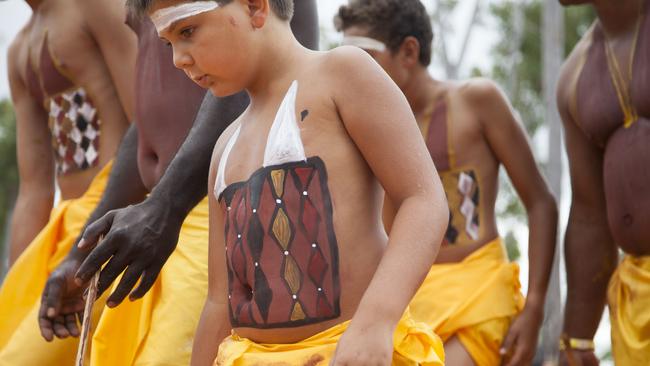All Garma hails king Galarrwuy Yunupingu
Calls for a treaty are gathering momentum.

Garma 2016 was, without question, the festival of Galarrwuy Yunupingu. Mick Gooda best summed it up when he took to the podium to tell how he had, as an Aboriginal youth in Joh Bjelke-Petersen’s Queensland, thought of the emerging Yolngu leader as a “black Superman”.
The proud Arnhem Land artist, intellectual and cultural warrior had acquired, Gooda said, a stature akin to that of champion US boxer Muhammad Ali for the recognition he demanded for his people. Land rights — the 1963 Yirrkala bark petitions, the fight over mining access at Gove — reverberated around Australia, and the young Gumatj man Galarrwuy was emerging front and centre in the struggle.
No matter that a now-enfeebled Galarrwuy wasn’t even in earshot of the open-air venue at Gulkula in northeast Arnhem Land this week when Gooda made his pronouncement.
Because when the old man did finally arrive, emerging unsteadily from the passenger side of his distinctive 4WD with flames painted across the bonnet and custom numberplate GURTHA — the “sacred fire” that is, along with the saltwater crocodile, one of Galarrwuy’s totems — Gooda needed little prompting to repeat his praise for the host’s benefit.
In the words of the hit song that prompted the comparison to Ali all those years ago, Galarrwuy in his prime was the sort of person who “floats like a butterfly and stings like a bee”.
The Aboriginal and Torres Strait Islander social justice commissioner, at that point just hours off being appointed royal commissioner to investigate juvenile detention in the Northern Territory, beamed as he declared it for a second time.
Galarrwuy nodded silently in appreciation, smiling faintly.
And so it was across the four days of an annual gathering in red dirt and contested politics that, since its first iteration in 1998, has been about presenting Yolngu culture as the equal of anything produced on this continent, and certainly as more sophisticated than anything that has passed for government in the Northern Territory.
Leaders, black and white, leapt to their feet at various forums to declare allegiance: Noel Pearson with a floridly poetic tribute, Pat Dodson in his preacher’s stentorian baritone, federal Indigenous Affairs Minister Nigel Scullion. Regardless of seniority in their own communities, each was eager to show that on his own country, Galarrwuy had the respect of a king among men.
But perhaps the most important fealty paid was one whose significance most of the corporate guests, toting their branded cardboard folding deckchairs from event to event, would barely have registered.
Even though Garma is in large part marketed at these captains of industry and their factotums, the opening ceremony — in the softening light of a late Friday afternoon with a southeasterly gale pounding the stringybark forest and its undergrowth of nylon camping tents — was not for a minute about them.
It was about Galarrwuy, and by extension the future of his Gumatj people. And it was defiantly, belligerently and triumphantly staking a claim for bigger and even better things to come. As the mining boom on which the Gumatj built their fortune fades, they are transferring their land management skills across a range of sectors: cattle, agriculture, timber, fishing and more.
And the theme of this year’s gathering — land rights law, in the year of the 40th anniversary of the land rights act and the 50th anniversary of the Gurindji strike that led to it — is key to it all.
For all the communal dancing on the ceremonial bunggul ground that was to follow, all the lessons in spear-making and basket-weaving and bush medicine, actor Jack Thompson reading poetry around the campfire at night or musician William Barton showing up with his didgeridoo for an impromptu solo rendition, and the wide variety of indigenous bands on the main stage each night as the sun went down, this one moment was perhaps the most important.
A line of painted Gumatj men emerged from the bush, where their secret ceremony at the distant men’s ground had been audible for some time, to be greeted by equally fabulously painted women and children; the whole of them to advance on a waiting Galarrwuy, chanting allegiance to country and therefore to him.
The Yolngu are not the only people in the world to align the group with the individual.
In Yolngu matha, the language which all Galarrwuy’s people speak before they even can imagine speaking English, even imagine there being a language called English, the word means person. Yolngu. Person.
And in the same language, garma broadly refers to those elements that can be known by the populace. Hence the festival, which is directed outwards, and is both educational and entertaining for the vast numbers of non-indigenous campers among its 3000 attendees.
Ngarra, on the other hand, is the sacred law. Ngarra encompasses notions such as makarrata, the “coming together after a disagreement” that was invoked after Bob Hawke’s famous 1988 call for a treaty, itself roundly questioned a decade later in the worldwide hit by the Yolngu band Yothu Yindi, led by Galarrwuy’s brother.
In between, if garma and ngarra can be thought of as existing on a continuum, is dhuni, sometimes described as the Yolngu equivalent of a ruling cabinet in the Westminster parliamentary system, or a boardroom in the corporate world.
So it was from within this world of dhuni that the column of male dancers emerged from the bush and entered the swept-earth column in front of Galarrwuy at the festival’s opening, to be followed by the women and children as they approached their leader.
And as they sang the beginnings of country, sang the words of the ancestor crocodile naming everything he first saw and all the places where he embedded himself — and the fire that by his own greed eventually consumed him — they declared their allegiance.
Their bodies painted with the emblems of their country, oblivious to the click of camera shutters, they laid out, in the absence of a written legal system defining boundaries, the extent of their nation; singing it, as they have done countless times before across hundreds of generations, into perfect, reconcilable order. Singing it thus, they approached him. In doing so, their invocation consecrated the ground for the following days of debate and festivities, the dancing of the women and children behind them bolstering their claims to success in this endeavour.
And as is the nature of such things in the Yolngu world, if those observing the goings-on understood them, then they deserved to. And if they didn’t, well, they were simply not ready, and might never be.
The speeches that followed, however, were simpler for the gathered political and business elite to understand. “Our message is unity; we are proud Yolngu and proud Australians,” Galarrwuy was told by the men who had just now sung the extent of his country. “But to find unity we need a settlement that lets us stand proud on our land forever and a day.”
It was a message for which Galarrwuy himself had primed them, for the simple reason that he would deliver it publicly and in plain language the next day. Land rights, he would say, was in desperate need of having life breathed back into it because, as things stood, the traditional owners still had the least of places at the table.
It was time, that is, for a conclusive legal framework where the singing of country by the ancestor saltwater croc has an absolute mirror in Westminster law.
Time, that is, for an enduring treaty.


